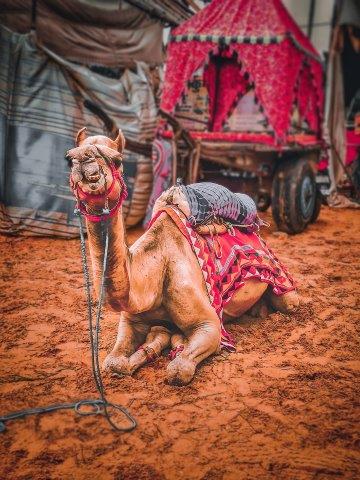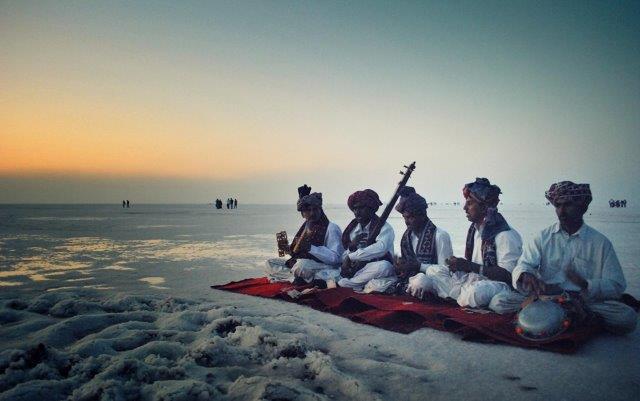India is as colorful as it gets. India is a land of different cultures, traditions and customs and this fact is visible in the various fairs which take place in different parts of the country. Fairs are an intrinsic and recurring part of the ancient way of Indian life. Fairs in India are inspired from its ancient customs, religious beliefs, harvest season, changing weather, local culture and folk lore & tales.
In this blog we take into account some of the most popular fairs of India that draw heavy attention and crowd both domestic and international.
Kumbh Mela
Accepted as the ‘mother of all fairs’ taking place not only in India but all over the world with its duration, budget, diversity, colours, intensity and number of attendees. The Purna Kumbh Mela drew almost 140 million people in 2013 in the city of Prayagraj on the banks of river Yamuna. A whole temporary functional city is set up on the banks of the river to cater to the people arriving and living here. It is the largest gathering of mankind in the world.
The fair is more than 2000 years old and the first written evidence is found in the writings of the Chinese traveler Xuanzang who had come to India during the rule of the great king Harshvardhan.
Kumbh Mela Cycles
Maha Kumbh Mela – is held every 144 years (after 12 Purna Kumbh Melas) – only in Prayagraj.
Purna Kumbh Mela – is held every 12 years (to mark the revolution of Brahaspati (Jupiter) around the Sun) – last one took place in January 2013 in Prayagraj.
Ardh Kumbh – 6th year after Purna Kumbh Mela takes place in Prayagraj at the confluence of Ganga, Yamuna and Saraswati (Uttar Pradesh), on the banks of Godavari at Nasik (Maharashtra), river Ganga at Haridwar (Uttarakhand), river Shipra at Ujjain (Madhya Pradesh).
Magh Mela – an annual festival, held every year except years of Kumbh Mela and Ardh (Half/Part) Kumbh Mela. Takes place in Magh (Jan-Feb); hence the name (takes place always in Prayagraj).
Rann Utsav, Kutch
The great Rann of Kutch is a white salt marsh in the Thar Desert in Kutch, Gujarat. The Rann of Kutch is the only huge flooded grassland zone in the Indo-Malayan realm. Rann Utsav is powered by the TCGL (Tourism Corporation of Gujarat Limited) and is responsible for bringing the ‘White Rann Experience’ to the enthusiasts. It is a festival that celebrates life with scenic beauty, engaging events, melodious music, soothing dance and mouth-watering local food. What started as a 3-day event it now stretches to 107 days speaking volume of its success and the response it receives. Rann Utsav is one of the most cherished tourism events in India, which celebrates the enchanting beauty of nature at the White Desert and the rich cultural and artistic heritage of Kutch. Since its inception in 2005, the bookings have grown exponentially, drawing over 5,00,000 travellers from more than 20 countries. A walk in the white desert on a full-moon night is an experience like no other.
Hornbill Festival & Fair
This is an annual celebration that is brought to life from 1st to 07th of December, in the north-eastern state of Nagaland. The fair is held to preserve and nurture the cultural heritage of Nagaland, encourage inter-tribal interaction. To showcase the local customs the State Government of Nagaland organises the Hornbill Festival every year. The first festival was held in 2000. To visitors, the festival offers a clear glimpse and a sound understanding of the Naga culture. This festival aims to ensure that the Naga culture is cherished, preserved and protected. And thus, the festival is celebrated with pride and gusto.
The fair is named after the Indian hornbill, which is a large and colourful bird found in the north-eastern part of India and is popular in the intrinsic culture of most of the state's tribes. Kohima, the capital city of Nagaland boasts of hosting the festival.
Pushkar Fair

It is also called the Pushkar Cattle Fair or Pushkar ka Mela (in Hindi). It is a multi-day livestock fair held annually and it also comprises of cultural events held in the town of Pushkar in Rajasthan hence the name. The fair commences with the Hindu calendar month of Kartik and stretches until the end of the Kartik Purnima, which typically falls in late October and early November. The Pushkar fair attracts over 210,000 visitors.
The Pushkar fair is India's largest and the most colourful cattle fairs trading in horses, camels, goats, cows and buffalos. Along with the trading of livestock, it is a crucial pilgrimage season for religious Hindu pilgrims to the Pushkar lake. Pushkar fair is an important tourist attraction for travellers both domestic and international given the pleasant weather and the abundance of colourful cultural themes with insights into the Rajasthani culture. Entertaining competitions which include dance and music competition, tug of war between women and men, the "Handi phod’, famous "longest moustache competition’’, cattle races and many other entertaining events are part of the fair with local delicacies ready to be served.
Surajkund Fair of Arts and Crafts
It’s the largest arts and crafts fair in India which is held every year in Surajkund (8 kms from South Delhi). The fair is most popular among all fairs and festivals in Haryana and entices visitors and lovers of art and crafts in large numbers from all parts of the country. The fair is an annual event organized by Haryana Tourism Board from 04th to 25th February. The fair is intended for bringing to light the immense talent of artisans and encouraging local craftsmanship in India who display their elegant handlooms and artsy handicrafts before a large number of arts and craft enthusiasts at the fair.
The prices are affordable at the fair that makes shopping an absolute delight! Visitors can shop for some beautiful mirror-embroidered stuff, delicate lacework, folk motifs on terracotta forms, metal and cane ware, shimmering bangles, soft silk apparel, toys and trinkets. The fair also offers harmonious folk music and dance performances every evening.
In the past decade, various cultural fairs and festivals meant for carrying music, dances, art and crafts into the lives of people and to support the artists have also been introduced. This latter category is usually tourism-oriented and tourist friendly. Examples of this are the Rajasthan International Folk Festival (RIFF) in Jodhpur, Jaisalmer Desert Festival and the Khajuraho Dance Festival, where renowned Classical Indian dancers perform against the backdrop of the famous Khajuraho temples complex.
 info@indiaunfolds.com
info@indiaunfolds.com
